
views
Practicing Your Driving
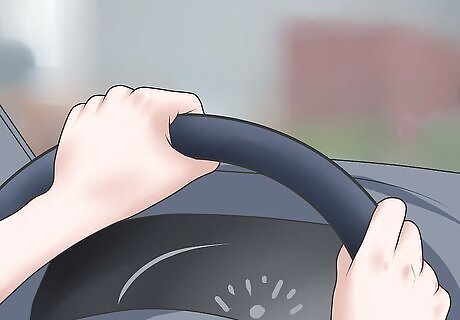
Take small steps. If you are too nervous to drive across town, make a shorter trip -- even if it is just around the block. Do not get yourself so worked up that driving becomes a bigger deal than it is. Unless you are overwhelmed with anxiety and terrified to get into a car, make yourself drive. Remember, even taking a small step still counts as practice. Push your comfort zone a little at a time. For example, you may want to start by sitting in a parked car, getting used to all the controls, before you ever put the key in the ignition. Once you are comfortable doing that, you may want to start the car, shift the car into drive, and then back into park. Slowly build on your comfort level. Figure out if your fear of driving is generalized or specific to one aspect of driving. If it is the latter, practice mastering the feared skill. For example, you may be terrified to parallel park. You may wish to find an empty street where you can practice maneuvering between safety cones, and when you have mastered that, perhaps you can try parking between two friends' cars.
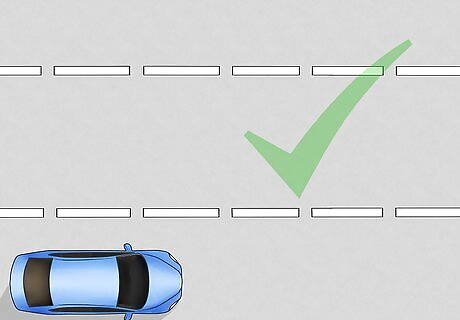
Drive away from others. Get used to driving in quiet areas before practicing in traffic. Find quiet side streets or an empty parking lot, and get used to starting, stopping, signaling, turning, reversing, and so on. Learn to control your vehicle and to find the controls someplace where you don't have to worry about traffic or other drivers. Work up to busier roads and longer drives as you start to feel comfortable operating the car. You may wish to practice driving only during the day at first. You will feel more confident simply because you are able to see better.

Go out with a friend or family member. Driving with someone you trust may help you to feel at ease in the car. If anything bad should happen, this person will be there to assist and advise you, and even to take over if traffic or conditions gets to be too much for your experience or confidence level. Make sure you are driving with a person who is naturally calming to you. For example, you probably want a person who will calmly tell you, “Oops, looks like we missed the turn back there. How about you pull into this parking lot and turn around?” instead of shouting, “That's where we needed to turn!” Let your friend or family member know how they can be supportive to you in the car. Maybe you would like them to tell you about their day to help keep your mind calm. Or maybe you would prefer quiet to concentrate.
Learning about Cars and Driving

Read your owner's manual. By learning more about your car, you can find out how it works, learn about its safety features, and learn how to troubleshoot problems. A better understanding of a car makes you feel comfortable with it. Learn about the parts of your car, and then experiment with your driving, away from other cars, to see how they work. For example, if your car has anti-lock brakes (ABS), try them out in a safe place, before you need to use them. Get up to a medium speed, and press the brake hard. You may feel the pedal pulse, or hear a pulsing noise. That's exactly what it's supposed to do. Anti-lock brakes are designed to stop your car in the shortest possible distance, by automatically pulsing the brakes to prevent you from skidding. Get used to your own car. It may be better for you to practice driving in the same vehicle until you get more confident. All cars are a little different and have their own quirks.
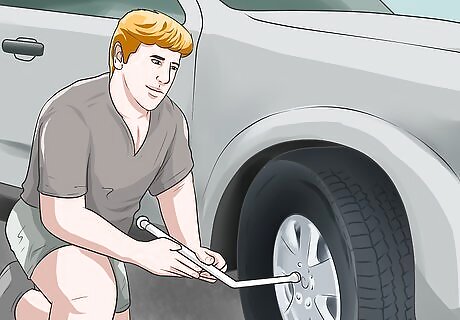
Teach yourself basic car maintenance. Learn how to fill up washer fluid, replace fuses, put air in your tires, or replace windshield wipers. Getting comfortable with the parts of your car, even if they are very basic, can help you feel more confident and less anxious. Learn how to change a tire. A lot of people are afraid of what they will do in the event of a flat tire. If you can change a tire, you will not need to wait at the side of the road for help. You can feel empowered to solve your problem.

Review the rules of the road. Consult the highway code or book an appointment with a qualified driving instructor. Feeling knowledgeable about rules and expectations can help your confidence. Watch safe driving videos online. If you can't get to a class, try watching videos to build skills and increase your confidence level.

Take a defensive driving class. Learn to identify and correct or avoid difficult situations, before they become emergencies. Your anxiety level may be reduced by feeling more prepared to handle problematic scenarios. Not only will you learn valuable, confidence-boosting driving skills, but you can often get a discount on your insurance premiums for completing a reputable defensive driving training course.
Staying Calm While Driving
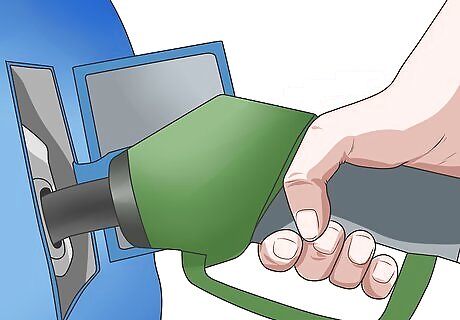
Be prepared for your drive. To lessen your anxiety, it might help you to have everything ready for your journey. Figure out what items or steps you could take that would make you feel better, and then plan ahead. For example, you might wish to: Fill up the car with gas. Check the tire pressure. Have a first aid kit in the trunk. Have phone numbers of people to call in case of an emergency. Have directions printed out or ready to go in your phone before you leave.
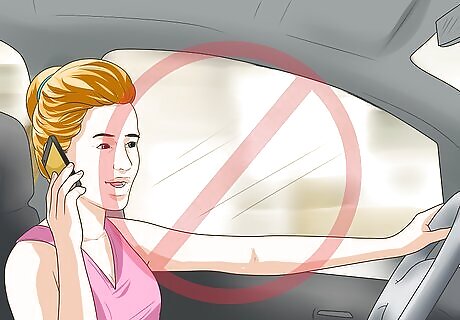
Practice safe driving. Don't engage in risky behavior, like speeding or looking at your phone while driving, that could increase your anxiety level. It also increases your risk of an accident. Do not feel like you need to drive more aggressively than you are comfortable with. For example, a lot of people accelerate through yellow lights, but you might want to drive more cautiously until you feel less anxious and more confident. Do not talk on the phone while driving, and never text and drive. Your phone can wait until you arrive. Don't worry about what other people on the road are doing, even if they're honking or speeding around you. Just focus on the road ahead of you and driving safely.
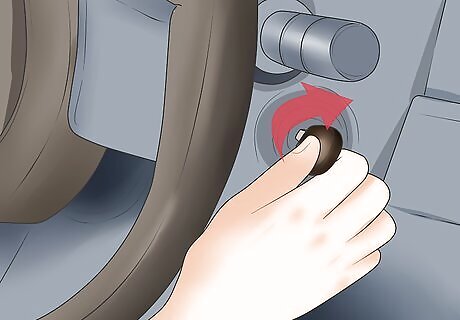
Practice visualization techniques. Visualization tricks your brain into feeling like you were actually there. It helps you feel calmer and more confident, because you are now able to draw on the “experience” you already have. Before you start driving, close your eyes and breathe deeply. Try imagining yourself going through all the steps of starting the car: buckling your seat belt, turning on the engine, getting out of your parking place, and successfully driving to your destination with confidence and calmness. Visualize the route and passing landmarks on your route if you can.
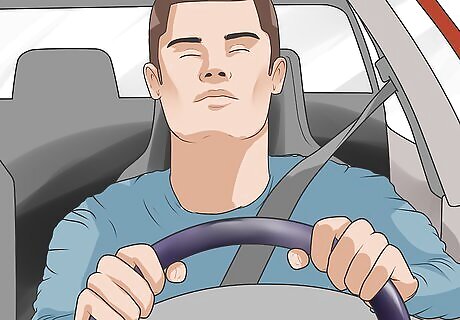
Utilize deep breathing techniques. Focusing on your breathing can help you remain present and calm. Once you get good at mindful breathing, you will find it to be a relaxation tool you can utilize anywhere! An easy technique to try while you are driving is simply breathing in through your nose, feeling your belly and lungs expand as air fills your body, and then fully exhale out your nose.
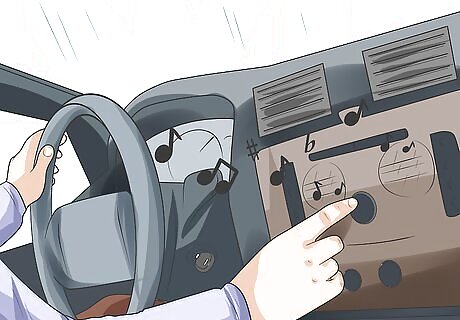
Listen to music to help you calm down. Relaxing music at low volume can help you calm down. Do not listen to anything that will further agitate you.

Talk or sing to yourself. Lift your spirits with positive or silly words and fun songs. Maybe you only want to do this when you are alone so you don't feel self-conscious. For example, you could repeat a mantra, like “I'm doing a great job. I'm confident and calm. I will get to my destination on time and safely.” Make yourself laugh. Be silly with your speeches -- no one is going to hear you! For example, you could narrate your drive like you're in a race car: “She's coming round the corner… will the Accord let her merge? YES! She's moved into first place, ladies and gentlemen!” Laughter will help you relax. Singing your favorite, guilty-pleasure songs at the top of your lungs can help you enjoy yourself. Not only is it fun, but singing helps you focus on your breathing and remain present, which helps relieve stress.

Consider more help. If you have tried some relaxation techniques and are still feeling anxious behind the wheel, you may wish to seek counseling from a counselor who specializes in phobias. Fortunately, with professional help, phobias generally require fairly straightforward treatment. You will most likely work with a professional using exposure therapy techniques; that is, getting a little more comfortable with one aspect of driving at a time, slowly building your tolerance level. You may also wish to learn more about Overcoming a Driving Phobia.




















Comments
0 comment